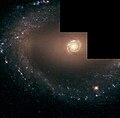| NGC 1512 | |
|---|---|
 NGC 1512 and NGC 1510 imaged by the Cerro Tololo Inter-American Observatory | |
| Observation data (J2000 epoch) | |
| Constellation | Horologium |
| Right ascension | 04h 03m 54.1662s [1] |
| Declination | −43° 20′ 55.658″ [1] |
| Redshift | 0.002995±0.0000100 [1] |
| Heliocentric radial velocity | 898±3 km/s [1] |
| Distance | 11.6 Mpc (38 Mly) h−1 0.73 [2] |
| Apparent magnitude (V) | 11.1 [1] |
| Characteristics | |
| Type | SB(r)ab [1] |
| Size | 213,140 ly (65.38 kpc) (estimated) [1] |
| Apparent size (V) | 8.9′ × 5.6′ [1] |
| Other designations | |
| ESO 250- G 004, IRAS 04022-4329, 2MASX J04035428-4320558, MCG -07-09-007, PGC 14391 [1] | |
NGC 1512 is a barred spiral galaxy approximately 38 million light-years away from Earth [2] in the constellation Horologium. It was discovered by Scottish astronomer James Dunlop on 29 October 1826. [3]
Contents
The galaxy displays a double ring structure, with a (nuclear) ring around the galactic nucleus and an (inner) further out in the main disk. The galaxy hosts an extended UV disc with at least 200 clusters with recent star formation activity. [4] NGC 1512 is a member of the Dorado Group. [5]



